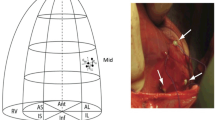Abstract
The objective of this study was to validate a recently developed tissue tracking (TT) method for cardiac motion, by comparing it with precise invasive measurements of motion and to prove its capability to reflect moderate hemodynamic changes induced by asynchronous activation. In four open-chest sheep, sono-crystals measured the left ventricle(LV) equator’s diameters simultaneously with 2D ultrasound acquisition. The LV was paced either from the posterior or from the lateral wall, just prior to the normal LV activation. Global functional indices were calculated based on the regional motions extracted by the TT method. The correlation coefficient between the shortening of the diameters and the global circumferential strain (GCS) was 0.99 ± 0.004. The peak GCS differentiated between the pacing modes (paired t test, P < 0.05). The GCS, a measurement closely based on the TT method, followed the precise sono-crystals measurements and reflected moderate hemodynamic changes, thus providing a substantial proof of the TT method’s accuracy and clinical value.






Similar content being viewed by others
Abbreviations
- GCS:
-
Global circumferential strain
- DS:
-
Diameter shortening
- TVI:
-
Tissue velocity imaging
- TT:
-
Tissue tracking
- LVP:
-
Left ventricle pressure
- AF:
-
Aortic flow
- CC:
-
Correlation coefficient
References
Adam D, Landesberg A, Konyukhov E et al (2004) Ultrasonographic quantification of local cardiac dynamics by tracking real reflectors: algorithm development and experimental validation. Proc Comput Cardiol 31:337–340
Armstrong G, Pasquet A, Fukamachi K et al (2000) Use of peak systolic strain as an index of regional left ventricular function: comparison with tissue Doppler velocity during dobutamine stress and myocardial ischemia. J Am Soc Echocardiogr 31(8):731–737
Barold SS (2001) What is cardiac resynchronization therapy? Am J Med 11:224–232
Bohs LN, Geiman BJ, Anderson ME, Gebhart SC, Trahey GE (2001) Speckle tracking for multi-dimensional flow estimation. Ultrasonics 38:369–375
D’hooge J, Heimdal A, Jamal F et al (2000) Regional strain and strain rate measurements by cardiac ultrasound: principles, implementation and limitations. Eur J Echocardiogr 1:154–170
Hein A, O’brien WD (1993) Current time-domain methods for assessing tissue motion by analysis from reflected ultrasound echoes: a review. IEEE Trans UFFC 40(2):84–102
Kaplan D, Ma Q (1994) On the statistical characteristics of log-compressed rayleigh signals: theoretical formulation and experimental results. J Acoust Soc Am 95(3):1396–1400
Kowalski M, Kukulski T, Jamal F et al (2001) Can natural strain and strain rate quantify regional myocardial deformation? A study in healthy subjects. Ultrasound Med Biol 27(8):1087–1097
Lang RM, Vignon P, Weinert L, Bednarz J, Korcarz C, Sandelski J et al (1996) Echocardiographic quantification of regional left ventricular wall motion with color kinesis. Circulation 93:1877–1885
Moore CC, Lugo-Olivieri CH, McVeigh ER, Zerhouni EA (2000) Three-dimensional systolic strain patterns in the normal human left ventricle: characterization with tagged MR imaging. Radiology 214:453–466
Pislaru C, Abraham TP, Belohlavek M (2002) Strain and strain rate echocardiography. Curr Opin Cardiol 17:443–454
Rappaport D, Adam D, Lysyansky P, Riesner S (2006) Assessment of myocardial regional strain and strain rate by tissue tracking in B-mode echocardiograms. Ultrasound Med Biol 32(8):1181–1192
Reisner SA, Lysyansky P, Agmon Y, Mutlak D, Lesick J (2003) Computerized eyeballing: a novel method for the assessment of left ventricular function. J Am Coll Cardiol 41:438A
Sarubbi B, Li W, Somerville J (2000) QRS width in right bundle branch block: accuracy and reproducibility of manual measurement. Int J Cardiol 75(1):71–74
Sutherland GR, Stewart MJ, Groundstroem KW, Moran CM, Fleming A, Guell-Peris FJ et al (1994) Color Doppler myocardial imaging: a new technique for the assessment of myocardial function. J Am Soc Echocardiogr 7:441–458
Author information
Authors and Affiliations
Corresponding author
Rights and permissions
About this article
Cite this article
Rappaport, D., Konyukhov, E., Adam, D. et al. In vivo validation of a novel method for regional myocardial wall motion analysis based on echocardiographic tissue tracking. Med Bio Eng Comput 46, 131–137 (2008). https://doi.org/10.1007/s11517-007-0281-z
Received:
Accepted:
Published:
Issue Date:
DOI: https://doi.org/10.1007/s11517-007-0281-z




